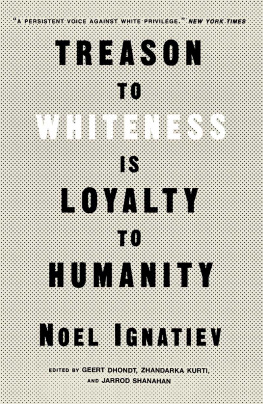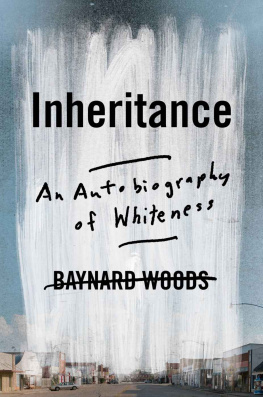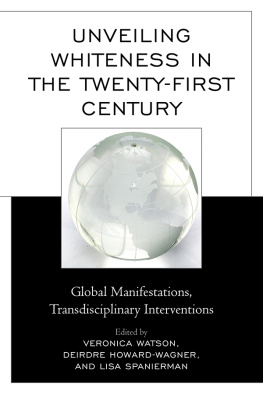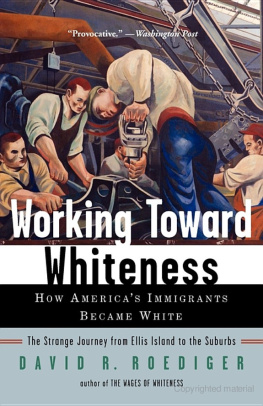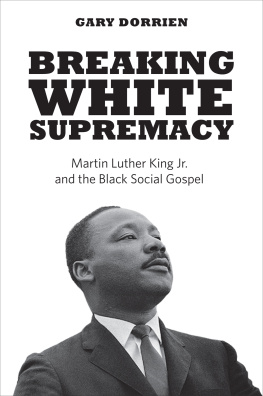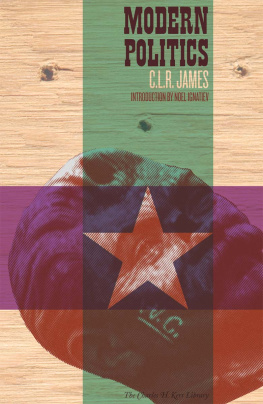Contents

Treason to Whiteness
Is Loyalty to Humanity
Geert Dhondt cotaught with Noel Ignatiev at Massachusetts College of Art and John Jay College, the City University of New York where he is an associate professor of economics.
Zhandarka Kurti is an assistant professor of Criminology and Criminal Justice at Loyola University, Chicago.
Jarrod Shanahan is an assistant professor of Criminal Justice at Governors State University, Illinois, and the author of Captives: How Rikers Island Took New York City Hostage.
All three are editors of Hard Crackers: Chronicles of Everyday Life.
Treason to Whiteness
Is Loyalty to Humanity
Noel Ignatiev
Edited with an Introduction by Geert Dhondt,
Zhandarka Kurti, and Jarrod Shanahan
With a Foreword by David Roediger
Afterword by John Garvey

First published by Verso 2022
Noel Ignatiev 2022
Foreword David Roediger 2022
Afterword John Garvey 2022
Introduction and editorial notes Geert Dhondt, Zhandarka Kurti, and Jarrod Shanahan 2022
All rights reserved
The moral rights of the authors have been asserted
1 3 5 7 9 10 8 6 4 2
Verso
UK: 6 Meard Street, London W1F 0EG
US: 20 Jay Street, Suite 1010, Brooklyn, NY 11201
versobooks.com
Verso is the imprint of New Left Books
ISBN-13: 978-1-83976-501-8
ISBN-13: 978-1-83976-505-6 (US EBK)
ISBN-13: 978-1-83976-502-5 (UK EBK)
British Library Cataloguing in Publication Data
A catalogue record for this book is available from the British Library
Library of Congress Cataloging-in-Publication Data
Names: Ignatiev, Noel, author. | Dhondt, Geert L., editor. | Kurti, Zhandarka, editor. | Shanahan, Jarrod, editor. | Roediger, David R., writer of foreword. | Garvey, John, 1948 writer of afterword.
Title: Treason to whiteness is loyalty to humanity / Noel Ignatiev ; edited by Geert Dhondt, Zhandarka Kurti and Jarrod Shanahan ; with a foreword by David Roediger ; afterword by John Garvey.
Description: London ; New York : Verso Books, 2022. | Includes bibliographical references and index.
Identifiers: LCCN 2021055886 (print) | LCCN 2021055887 (ebook) | ISBN 9781839765018 (paperback) | ISBN 9781839765056 (ebk)
Subjects: LCSH: RacismUnited States. | Anti-racismUnited States. | Social conflictUnited States. | Working classUnited StatesSocial conditions. | United StatesRace relations. | United StatesSocial conditions.
Classification: LCC E184.A1 I36 2022 (print) | LCC E184.A1 (ebook) | DDC 305.800973dc23/eng/20211222
LC record available at https://lccn.loc.gov/2021055886
LC ebook record available at https://lccn.loc.gov/2021055887
Typeset in Minion by Hewer Text UK Ltd, Edinburgh
Printed and bound by CPI Group (UK) Ltd, Croydon CR0 4YY
To future generations of abolitionists, race traitors, and revolutionaries
Contents
Part I
THE WHITE BLINDSPOT
Part II
BLACK WORKER/WHITE WORKER: THE SOJOURNER TRUTH ORGANIZATION
Part III
ABOLISH THE WHITE RACE: THE RACE TRAITOR PROJECT
Part IV
DUAL POWER IS THE KEY TO REVOLUTIONARY STRATEGY
My first memorable meeting with Noel came during the US bituminous miners strike of 197778. Wed probably been around each other a few times before. I worked in the bookstore of a Chicago revolutionary collective, Red Rose Books, and much of the Chicago left periodically dropped in. I lived near the Stewart-Warner plant on the North Side, a site of Sojourner Truth Organization (STO) activity that Noel helped to lead, and friends sometimes asked for help leafleting on shift changes. As the Chicago Surrealist Group and the Charles Kerr Publishing Company became my political homes, I heard the praises of Noel sung, especially by Penelope and Franklin Rosemont. If some of my shallow earlier training on the Trotskyist left would have led to a temptation to dismiss STO as Maoist, the surrealists connected with Noel as a fellow enthusiast for the work of C. L. R. James.
Nevertheless that first actually memorable meeting (memorable for meI doubt it registered with Noel) made me less enthusiastic to know him. Surrealists and some others had organized a demonstration on behalf of the striking miners at Chicagos Museum of Science and Industry. The plan struck us as pure genius. The museum featured a mock-up of a working coal mine, corporate-sponsored and well-scrubbed enough to make extractive labor seem childs play, verging on an amusement park ride. By picketing it we got to talk to museumgoers, got into it with museum security, and made a little media splash. When we ran into Noel by chance afterward he greeted our account of our successes with So you picketed on behalf of a white supremacist organization, meaning the United Mine Workers. The long-time surrealists were ready with a reflection: Thats Noel. But being twenty-five years old, from a union family, and at the time a more or less standard issue labor historian in search of a usable past and an ennobling, uncomplicated present, I was less forgiving.
That didnt last long. Seeing Noel at the bookstore and at demonstrations, I came to like him lots. Of all the revolutionaries who had left universities to enter industrial jobs, he had the best stories and seemed the best listener to fellow workers. Acceptable Men, his forthcoming memoir of life at US Steel Gary Works, offers a sampling of such stories. It shows his capacity to be interested in how the shop floor empowered and immiserated and captures some of the wisdom distilled in his 1981 striking essay The Backward Workers, included in this volume. I found him funny and revolutionary, a rare enough combination. He clearly loved intellectual exchanges among radicals in a way that left him genuinely excited, if fierce. So many of us became clenched during political arguments, but Noel often seemed more relaxed and in his element as things heated up. In some waysthis will seem odd in that he was twelve years older than I and pushing 40Noel struck me as somewhat boyish, stretching to get comfortable, wise-cracking, provoking, and hoping for the best in the long run of the exchange no matter how tense it became.
Then, too, my own politics changed as I studied with my graduate school mentor, the great African American historian Sterling Stuckey, and with my informal teacher, George Rawick. With Sterling I read W. E. B. Du Bois systematically and with Rawick, James. Id known Noels writings on the white worker, with and without Ted Allen, from the 1960s (many of which are included in this volume), admiring them vaguely but without the need to take on the full import of their conclusions. That changed in reading Du Bois and in confronting Chicagos Nazis in the Marquette Park neighborhood. I did not come to think the miners organized for white supremacy but did come to know that their practice, heroic stories like those in the film Matewan notwithstanding, too often failed to break from it. By 1981, when Sojourner Truth Organization published a special issue of Urgent Tasks on James, I briefly wrote for it on Mariners, Renegades and Castaways. Noel also passed my rough litmus test for knowing if Id like people on the Chicago left: He understood the genius of and loved the extraordinary black anarcho-pacifist poet Joffre Stewart.
We shared some academic platforms, including the Making and Unmaking of Whiteness conference at Berkeley in 1995, a splashy announcement of critical whiteness studies that captured some of what would sustain that enterprise and much that would plague it. We spoke together with the novelist and historian Alexander Saxton at a textile factory museum in Lowell, before an aging but seeming ageless Saxton walked us into the ground in search of the best Portuguese food.

